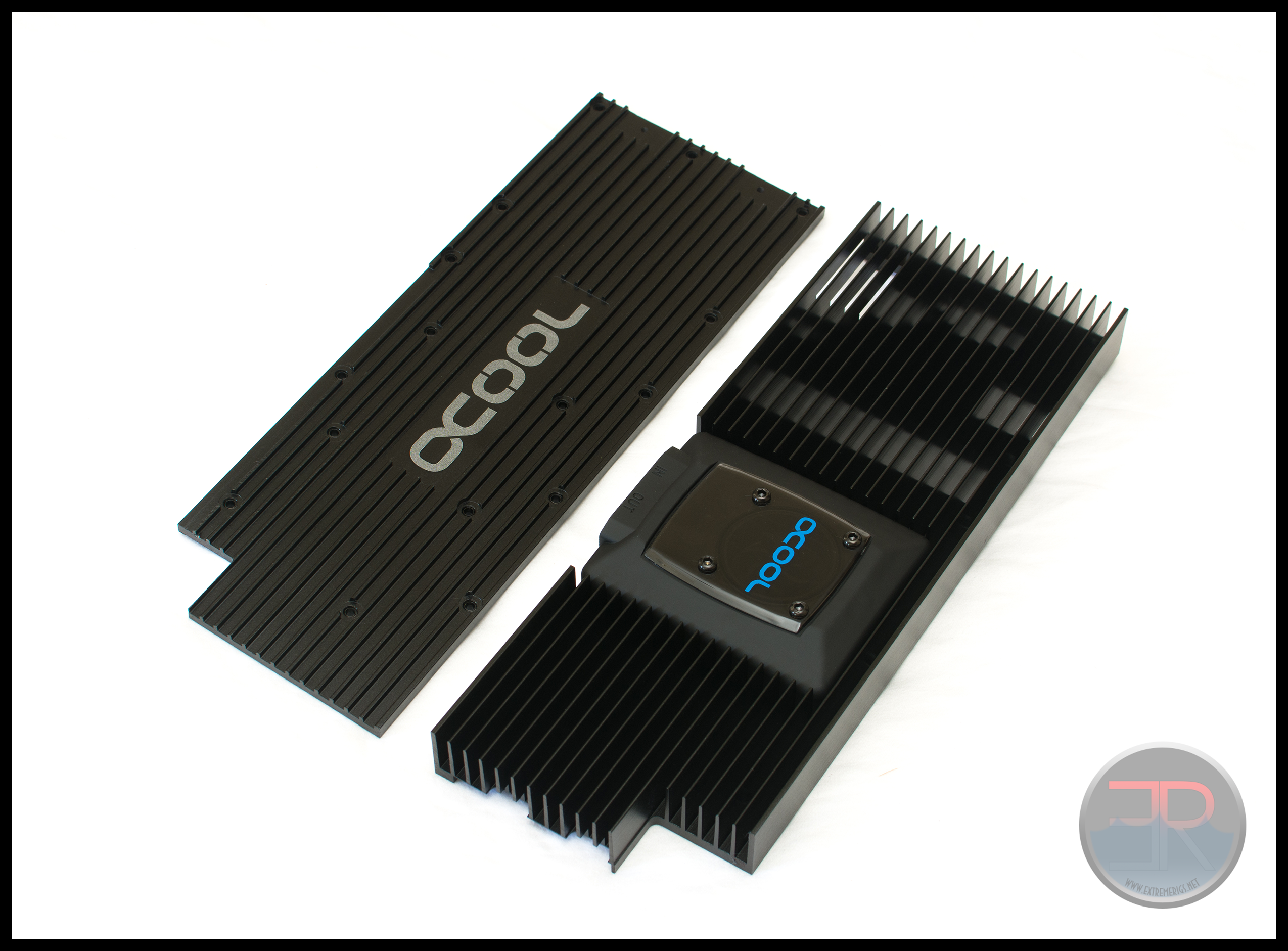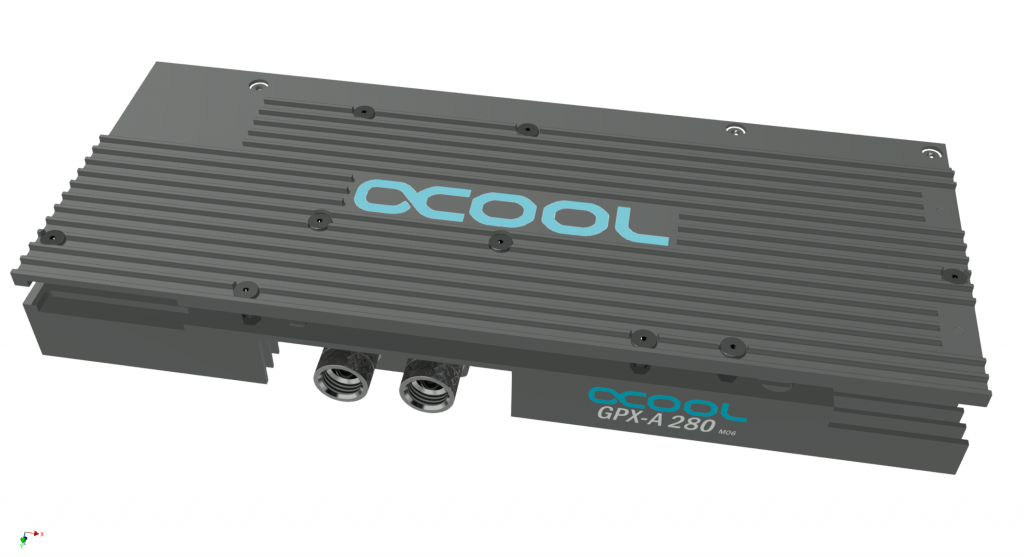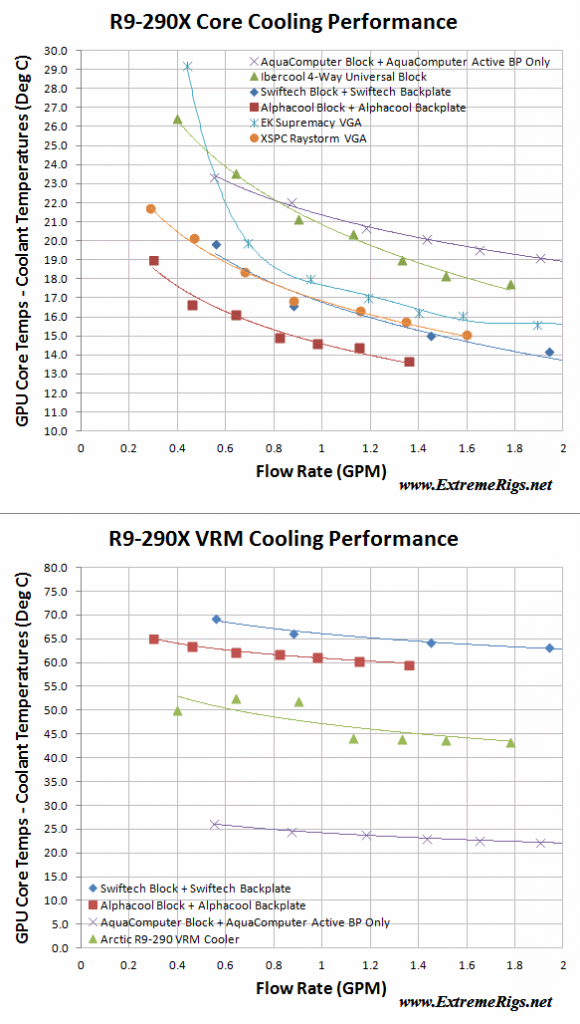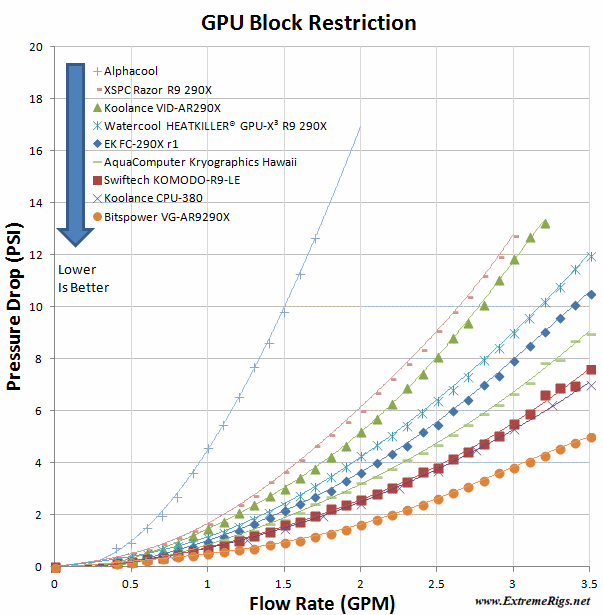This review is part of the R9-290X Water Block Roundup. This one was slightly hard to write because it got interrupted when this block and backplate combo from Alphacool managed to kill the R9-290 being used for testing. On the other hand it also makes it easy to not recommend the block due to compatibility issues. Read on for more…
This block is designed as a budget block that only cools the core directly while the rest of the PCB is cooled by aluminum plates. This reduces cost because aluminum is cheaper than copper and presumably the central core block can be reused on future products by buying only the $30 aluminum sections. The idea is not new – Swiftech did it quite a while back.
The block and backplate arrive in a typical alphacool style box:
Surprisingly there is no protection from damage at all:
Accessories are at least included:
The backplate doesn’t look bad, while the main block does look cheap.
The aluminum plate has cutouts for the various taller components such as capacitors:
In addition unlike most full cover blocks that have two pairs of ports this only has one pair that is less friendly to use in most computer cases and will most likely require a 90 degree rotary adapter that could reduce the $20 of cost savings that you would get by buying this block.
The backplate is seriously thick and ribbed for better surface area and hence cooling:
It is then combined with some seriously thick 3mm thermal pads that are put almost all over the card:
Alphacool claim the thickness is necessary for safety in order to avoid shorting the backplate to the solder joints on the back of the card. If this were the case other manufacturer’s would have similarly thick pad. On the other hand other manufacturer’s use pads between 0.5mm and 1.5mm thick. Using 3mm is in other words lazy because otherwise the backplate would have to be machined like the others to avoid some of the more dangerous areas.
Similarly the thermal pads on the front of the GPU are 1.5mm thick:
Again this is unnecessarily lazy and will lead to unnecessarily worse thermal performance. Rather than machining the correct tolerances Alphacool said “eff it let’s just use thicker pads”. It’s not like this design was rushed out to market either and ready at launch it took about 9 months to be released! You have to ask yourself what they were doing all that time?
The end result is a comically thick sandwich:
The result of such lazy design is of course a compatibility issue. If you are using this on the first PCIE slot you should be extremely careful. My albeit tight Maximus VI Impact board had the backplate catch on the memory slots. Even though I suspected this would be an issue, the card looked like it was in the slot just fine, but powering on killed the card. Later wiggling showed that the card wasn’t in fact 100% of the way in the slot. The annoying thing was that Alphacool knew that compatability was an issue because they machined part of the ribbing away, but stopped too early. After the card died, and I got another card, I tried the backplate with two other motherboards – the first the Rampage IV Extreme – possibly the most popular enthusiast X79 ATX motherboard also had compatibility issues with the first slot. Similarly the Rampage IV Gene mATX board also had issues. In talking with Alphacool they mentioned this is because they hadn’t realized that Asus would be willing to break the motherboard/pcie specifactions. Alphacool claim to meet spec with this design. They also mentioned that they are redesigning the backplate to remove the lower ribs and use countersunk screws so as to reduce compatability issues in future. This is good – here is the proposed design style for future backplates that we expect to see for the GTX 980:
Thermal results
Because this cooler is part full cover block and part universal, I tried to compare it to both some universal blocks and some full cover blocks. For full cover blocks I used a Swiftech and AquaComputer block with their backplates. These were the best cooling options for core and VRM respectively. The universal blocks required some VRM cooling for which I used the artic cooling passive heatsink combined with a *lot* of airflow:
Core cooling is very impressive – this is not a surprise because this is essentially the same internals as Alphacool’s high performing CPU block. Other GPU blocks tend to use a more compromised design primarily for space. The downside to the core cooling however is that it’s an extremely restrictive block:
It’s far more restrictive than any other design and your flow rate will be affected when you add this to it.
VRM temperatures on the other hand are ok. They are better than the Swiftech block which is what I would consider the limit of acceptable, however they are still fairly far off from the “best”. It should be noted though that I only had slight air flow over the card, increasing this would I’m sure help with VRM temperatures a good amount.
Summary
This card is designed to be a budget alternative to the real deal water blocks. While up front you don’t save much ($96 vs the $118 for the EK block) the cost savings instead come when or if you upgrade your GPU. Then if a new backplate and front plate combo is still being designed and manufactured then you’ll be able to transition cheaply (assuming the price is cheap) to a fully watercooled new GPU. While the idea and the thermal performance on the core is good this block/backplate is however sloppily designed, unattractive and very restrictive. Outstanding core results only get you so far, but by far the biggest problem is the compatibility issue which mean that this version at least should be avoided.



























[…] Alphacool GPX-A290 AquaComputer Kryographics Hawaii Bitspower VG-AR290X EK FC-290X (Rev 1) Koolance VID-AR290X Swiftech KOMODO-R9-LE Watercool HEATKILLER GPU-X3 R9 290X XSPC Razor R9 290X – TBD! […]
[…] GPX GTX 980 – the M02 is the one that fitted our reference card. As we had reviewed the R9-290x version before – we were sent an upgrade kit. Wait – you might be asking – an upgrade […]
Comments are closed.